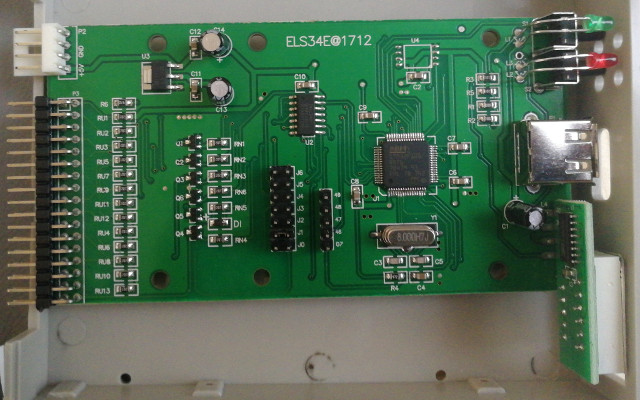Gotek Models
FlashFloppy is directly compatible with most Gotek devices with a 34-pin header. all of which share the SFR model prefix (eg SFR1M44-U100K, SFRM72-U100; though not all sellers mention the model name explicitly). Since the fixed-format (720kB vs 1.44MB) stock firmware is being replaced, this particular distinction between Gotek models is irrelevant: all of them can handle an almost infinite range of disk formats with FlashFloppy installed. The most relevant differences between Gotek models are colour, case style, and microcontroller.

These models provide a simple numeric indication of which disk image is currently selected. This number may not make much sense to you unless your disk images are explicitly numbered, or assigned to numbered slots by an image-selector tool. The display doubles as a track-number indicator during normal disk activity. Two buttons are used for navigating between disk images.
Note that there are some models with only a two-digit display, or even no display at all! These models are best avoided.

More recently the factory introduced an enhanced model fitted with a 128x64 OLED display and a rotary encoder. This allows disk images to be identified by name, and rapid navigation between images by rotating the encoder. The encoder integrates a push button for faster image selection.

Gotek devices have featured three generations of MCU: STM32F105, Artery AT32F415, and Artery AT32F435. If buying a new Gotek you are most likely to receive one of the Artery models, and of these I highly recommend the 435! You should ask the seller which MCU they supply, if it is not made clear in the sale listing. If you already have a Gotek you can determine the MCU by opening it and looking at the the chip, or by running latest FlashFloppy firmware and looking at reported SRAM size when no USB drive is inserted (on the three-digit display you will need to press right button to see SRAM size and firmware version).
The original Gotek microcontroller. A lot of online documentation, for example describing how to flash a Gotek, assumes this chip and may not be directly relevant to more recent models. This MCU runs at 72MHz and has 64kB SRAM. It is enough for reliable emulation of most disk types, including high-density HFE disk images, on a wide variety of host systems.
Due to lack of availability, the STM32F105 has not been used in Gotek production since early 2021.
Starting Spring 2021, the STM32F105 microcontroller previously used has been replaced with Artery AT32F415 due to cost and availability. The major disadvantage of this chip is its tiny 32kB SRAM which makes it difficult to reliably support some operations, such as track formatting, and writing to high-density HFE images. Reliability of these operations will depend on USB stick performance. Due to this limitation, I highly recommend the latest enhanced model with AT32F435 MCU for new purchases!
This MCU is supplied on a number of PCB types with different package sizes:
- SFRC922D (LQFP64): This PCB is shared with STM32F105; You cannot tell which MCU is installed without opening the Gotek.
- SFRC922AT3 (LQFP48): This PCB is missing the usual header pins for installing a rotary encoder; Instead the CLK/DT wires can be connected to pins PA13 (SWDIO) and PA14 (SWCLK) on the programming port.
- SFRKC30AT4, SFRKC30.AT4, SFRKC30.AT4.7 (LQFP64): Features the new KC30 rotary header.
- SFRKC30AT3 (LQFP48): Missing the original rotary-encoder header, but features the new KC30 rotary header.
- SFRKC30.AT2 (QFN32): Missing the original rotary-encoder header, but features the new KC30 rotary header. The first revision of this board is also missing the JC jumper location: PC interface mode can be specified only via FF.CFG.
Starting July 2022, the factory is supplying an enhanced MCU option: the Artery AT32F435. This MCU runs at 288MHz and has 384kB SRAM. It is enough for reliable operation, extensive image caching, and will allow for a wider range of firmware features in future. The enhanced firmware which runs on this MCU is called FlashFloppy PLUS (or FlashFloppy+).
This MCU is currently supplied on only one PCB type:
- SFRKC30.AT4.35 (LQFP64): Based on the SFRKC30.AT4 described earlier. Features the KC30 rotary header. The Motor signal can be passed through to the MCU by strapping MOR on the rear jumper block.
- UFA prefix (eg UFA1M44): Emulates a USB floppy drive and hence lacks the 34-pin header, which is replaced by a mini-USB socket. This model is entirely incompatible with FlashFloppy.
- DU26, TU26 suffix (eg SFR1M44-DU26): Emulates a slimline laptop drive, and hence has 26-pin header with integrated power, rather than the required 34-pin header. However, see #155 for one user's successful modifications to run FlashFloppy on a DU26.
-
FDD-UDD U144K: A Gotek variant with 34-pin header but a completely
different PCB layout with undocumented pin headers (see photo below).
I strongly recommend to avoid this model as it cannot be programmed
by the usual serial and USB methods, and it lacks convenient headers
for popular hardware additions.
However, see #232 for discussion of how to program this
model via JTAG, and header assignments.

- Models containing CH32F103 chip will not work due to insufficient SRAM. See issue #695. So far these are reported only in black case, with no display or buttons, and PCB model SFRC922D.

